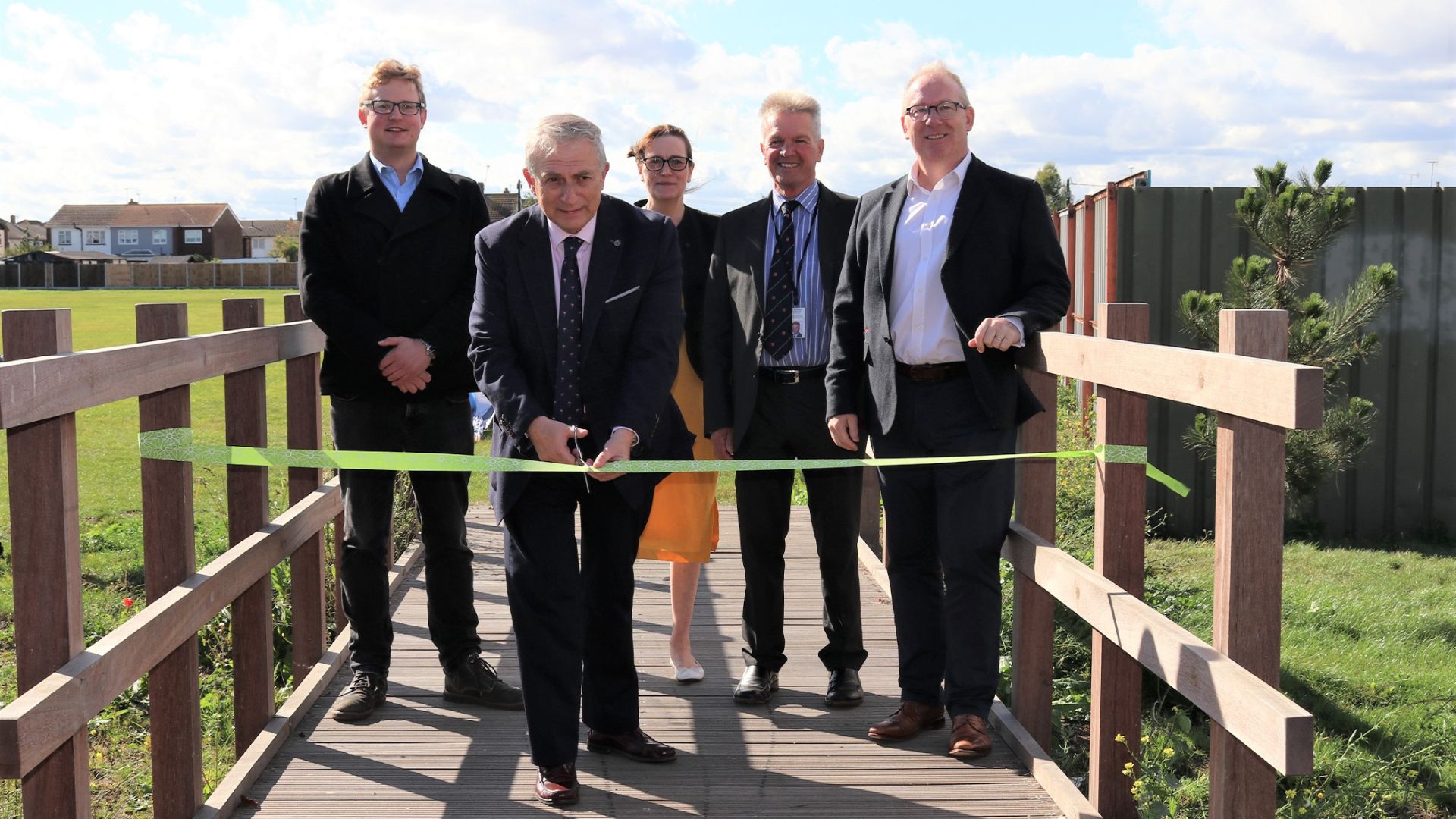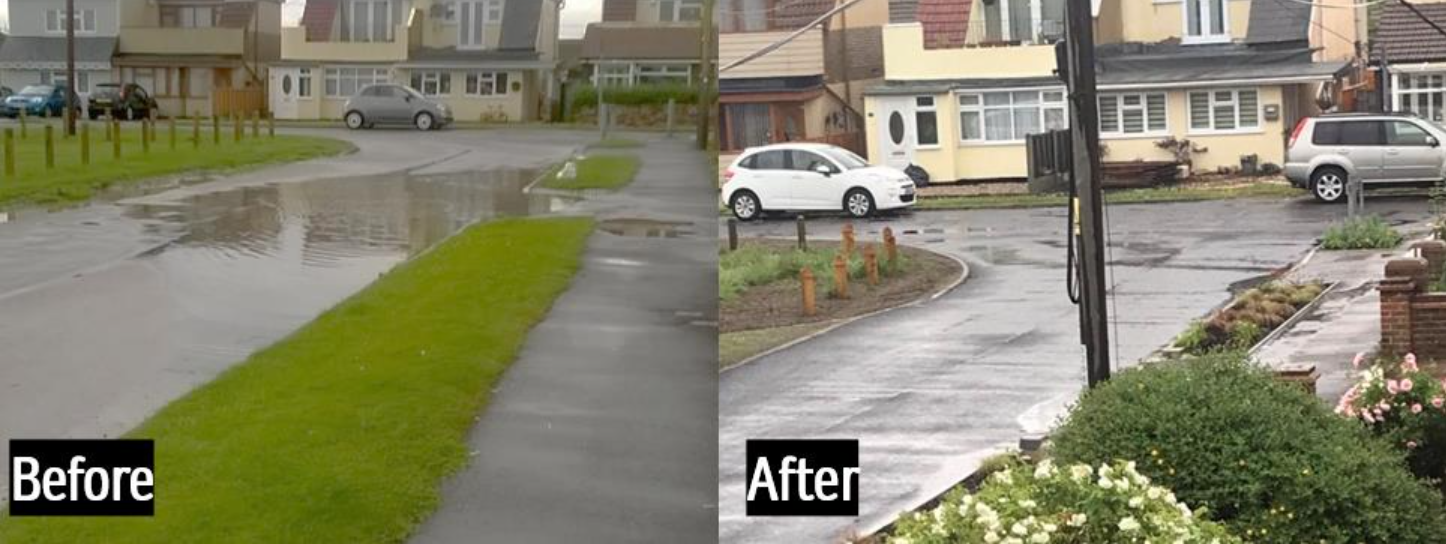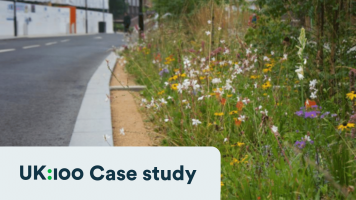A pilot green infrastructure scheme that uses rain gardens, swale, tree planting, and over 1,300 plants has helped to reduce surface water flooding on a residential street in Essex. The scheme, popular among residents, includes a footbridge to the greenspace, ‘X-grid parking’, and an information board that explains its features. After creating “one of the best-looking roads on Canvey”, the council is now finding other sites to scale up the scheme across the county.
Cllr Peter Schwier, Essex County Council Climate Czar, says: “This is a great, collaborative, sustainable design that addresses flooding while including many natural environmental features. It not only works well but gives significant benefits for the community and wildlife.”
On the night of 31 January 1953, a tidal surge hit Canvey Island in Essex. 59 people tragically lost their lives. While the island is now well protected by a sea wall, in recent years residents have suffered from surface water flooding. The most severe event occurred in 2014, when flooding to 1,000 properties was reported.
Essex County Council has undertaken management plans and feasibility studies across the island but finding technical solutions and justifying capital investment have been a challenge.
Park Avenue on Canvey Island is one street on the border of a critical drainage area. Properties here are at risk and constant surface water flooding – or ‘nuisance flooding’ – has created problems.
It is a typical Canvey Island street with about 20 homes: bungalows, semi-detached houses, and detached properties. The street is also flat and below sea level. While a system designed to pump water out to the Thames helps protect the area, the ground does not absorb enough surface water due to this low-lying topography. And during times of heavy rainfall, it has nowhere to go.
With the history of flooding in the area, there has been a lot of political pressure to resolve the flooding issues.
In 2019, a multi-agency partnership involving all flood management authorities began to consider a street-level retrofit of Park Avenue’s drainage systems using green infrastructure.
The aim of the project was to:
- reduce the risk of flooding by using the street’s grass verges and public open space to absorb surface water
- provide other benefits to the community like livening up the street with tree planting and an attractive planting scheme
The other option would have been to upgrade the traditional drainage in the road. But that would have added to the demand on an already struggling drainage system, and we decided against it.
The Main Rain Happy scheme
The ‘Make Rain Happy’ scheme for Park Avenue, a joint project between Essex County Council and Anglian Water, was initiated in 2019. The flood-blocking scheme’s main components are:
- installations of rain gardens, swale, tree planting, and over 1,300 plants
- a footbridge across the swale so residents can still access the greenspace during wet periods
- a permeable plastic grid to stabilise the ground and accommodate parking while still allowing water to infiltrate and grass to grow (‘X-grid parking’)

It was a pilot project as it was the first time green infrastructure had been installed to tackle highway flooding issues in Essex. The team designed and erected a lectern board by the footbridge to explain the scheme, its aims, and all its features to residents and visitors.
The Make Rain Happy scheme sits well in Essex County Council’s climate action plan for net zero. The incorporated tree planting in the design is another step towards our target to plant 375,000 trees across the county in 5 years. And the scheme meets the:
- aims of our green infrastructure strategy and 20 commitments to levelling up
- aspirations of the Lead Local Flood Authority team to use natural flood management where possible
We had a meeting with Anglian Water in 2019 which started the idea of delivering a green infrastructure project in Canvey Island. In total the scheme took 2 years to deliver from an initial concept to completion of the works. We held an opening ceremony in September 2021 attended by councillors, MPs, residents, and all stakeholders.

There were no delays on the build of the scheme apart from one week when heavy snow and waterlogged ground made it impossible to work. The opening ceremony took place 3 months after completion as we had to wait for Covid restrictions to allow such an event.
The scheme was a joint project between Essex County Council and Anglian Water, and it was delivered through the Essex Highways contract.
As the ‘Lead Local Flood Authority’, Essex County Council takes the lead on localised surface water flooding. We work closely with the district, borough, and city councils in Essex, along with many other organisations, under our Essex Flood Partnership Board.
For the Park Avenue project, this was no different. It was important to engage with the many different stakeholders to reach a solution everyone was happy with and achieve our desired outcomes. These included Anglian Water, Castle Point Borough Council (Canvey Island’s borough council), and residents.
Involving residents
With Groundwork East, a federation of charities passionate about creating a future where every neighbourhood is vibrant and green, we involved residents so that they:
- understood what we were trying to achieve
- could suggest flooding solutions they would have liked to see
- could feed into the plans and initial designs with any suggestions
- ask any questions
We explained any concerns residents had about the scheme, and residents gave ideas to improve it. One such idea was the footbridge across the swale (see ‘the solution). The council took this suggestion forward and incorporated it into the design.
Residents were pleased with the design and liked the fact that we worked together with Anglian Water and Essex Highways to find a solution to their flooding issues. They were keen on the improved parking solutions and the scheme’s attractive nature and green credentials.
There was not any resistance from stakeholders as it was a win-win scheme. We already had a good working relationship with Anglian Water and Castle Point Borough Council. And as the scheme progressed, door knocking, emails, and project-update letters helped us develop a good relationship with residents. The project was enjoyable to work on as everyone engaged well with each other.

The project was successful at reducing surface water flooding, looked attractive, and was popular among residents.

What residents said
“We have one of the best looking roads on Canvey now and all our houses are much better protected than before the scheme was in place. The recent heavy rain was a good test and, on the whole, the rain gardens seem to have worked well.” – Dan
“A really good project that looks great, is environmentally friendly, and after its baptism of fire with the recent heavy rains, seems to work well too!” – Mark
“What a difference this scheme has made to our road. The design of the swale and the planting of lots of trees and water-loving plants has enhanced the outlook immensely, not only for us in Park Avenue but also the local community who walk along the swale or the road towards the front. Hopefully more areas will be able to benefit from such a scheme.” – Debbie
The project was a success with residents partly because it gave us an opportunity to improve car parking through the installation of X-grid parking and resurfacing the road. Early and ongoing engagement with residents and involving the community in the visits and opening event was positive.
We had to make a few changes to the original design. For example, we needed to adjust the depth at various points in the rain gardens and use stones for drainage rather than the planned soakaway crates (plastic crates which allow water to percolate through the soil). Trial holes did not flag up the issue as the depths varied at different points in the road.
We learned a lot about a scheme’s finer details such as finishes, aesthetics, and getting levels correct for the scheme to function efficiently.
The whole scheme cost £260,000, which was jointly funded (50 50) by Essex County Council and Anglian Water. The money came from the floods team’s capital budget, and the multi-agency partnership for Canvey and Essex Flood Board made the scheme happen.
Due to the success of this scheme, we have now identified 3 new sites for rain gardens in Essex. These pilot schemes are currently in the design stages and should be delivered in the 2022 to 2023 financial year. We’re looking for additional suitable locations where we can do more.
For more information:
- contact floods@essex.gov.uk
- read more about Main Rain Happy: protecting your environment using sustainable drainage (7.5 MB PDF)
Header image credit: Essex County Council




